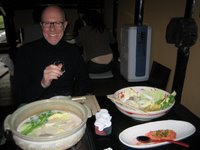
While in Osaka, we visited Daimon Sake Brewery for a tour followed by a tasting and then lunch. Daimon Brewery is actually located east of the city, about 45 minutes by train from Osaka Station. Founded in 1826, the kura (brewery) is situated in a small village bounded by a mountain range to the east from which it draws an abundance of clean water. Long ago, during Edo period this region between Osaka and Nara (the ancient capital prior to Kyoto) was populated with as many as 1,600 sake breweries. Currently, only a few remain.
 Yasutaka Daimon, the director and 6th generation of the Daimon brewing family, began with a brief introduction to the process of sake-making and then led a tour of the brewery. After learning about how the product was made, we tasted six different varieties that Daimon makes ranging from their fresh namazakes (unpasteurized) to their Junmai, Junmai Ginjo, and Junmai Daiginjo nihonshu (sake).
Yasutaka Daimon, the director and 6th generation of the Daimon brewing family, began with a brief introduction to the process of sake-making and then led a tour of the brewery. After learning about how the product was made, we tasted six different varieties that Daimon makes ranging from their fresh namazakes (unpasteurized) to their Junmai, Junmai Ginjo, and Junmai Daiginjo nihonshu (sake). After the tour and tasting, it was time for lunch. We were led to their small restaurant upstairs from the brewery and seated at a small shin high table. The lunch served was Sakekasu Nabe with Salmon paired with our choice of sake.
For those of you who may be wondering what Sakekasu Nabe is, here is the explanation.
Sakekasu comes from the process of making sake; when rice, koji (mold produced when rice is affected with yeast), and water is fermented, the liquid part becomes sake and the solid residue from that process is sakekasu. Nabe is a "hot pot" dish (think fondue with a broth cooking medium) that is very popular during the winter in Japan. Nabe simply means "pot," which is usually made from clay. The nabe (pot) is usually prepared over a gas burner on the dining table. Beginning with dashi (bonito flake based) stock, various ingredients like vegetables, mushrooms, meat or seafood are added to it once it comes to a boil. There are many regional varieties to this dish, and there are really no rules about what to put or not put into the nabe. It is a very social dish, and it is common for family and/or friends to gather around the nabe and drop fresh ingredients in the hot pot while they eat, drink, and talk at a leisurely pace. We observed four men enjoying their sake and nabe experience so much that their glacial eating pace necessitated some gentle nudging along by the servers when all other diners had finished. This is the way it is meant to be!
 The server brought us a big clay pot filled with dashi mixed with Sakekasu and placed in on the stove in the center of our table. While the Sakekasu dashi bubbled, we dropped the fresh vegetables and salmon into the hot pot to cook our meal. Sakekasu has the fragrance of sake... it was mild and not as sharp as miso flavor. The rich salmon was great compliment to the mild sake flavor. To go with this we ordered a nama (just-made fresh sake) to go with our lunch. It was the perfect meal for a cold winter day!
The server brought us a big clay pot filled with dashi mixed with Sakekasu and placed in on the stove in the center of our table. While the Sakekasu dashi bubbled, we dropped the fresh vegetables and salmon into the hot pot to cook our meal. Sakekasu has the fragrance of sake... it was mild and not as sharp as miso flavor. The rich salmon was great compliment to the mild sake flavor. To go with this we ordered a nama (just-made fresh sake) to go with our lunch. It was the perfect meal for a cold winter day!We left Daimon with our very own bag of sakekasu, compliments of the brewery. And although we had many more travels ahead of us, we were already thinking about making Sakekasu Nabe in Brooklyn.
More photos of eating in Osaka? Click here!
No comments:
Post a Comment